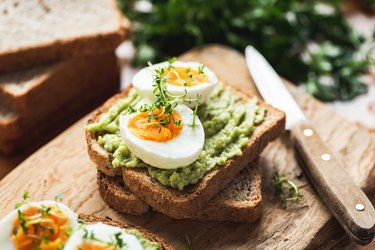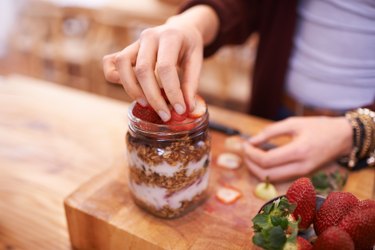
If you're managing your blood sugar, it can be frustrating to wake up to a high reading. But an elevated blood glucose level in the morning is actually a natural phenomenon known as the dawn effect.
As you wake up, your body produces the hormone cortisol, which can lead to a blood sugar spike that usually peaks around 7 or 8 a.m., explains Kunal K. Shah, MD, board-certified internal medicine doctor and assistant professor in the Division of Endocrinology at Rutgers Robert Wood Johnson in New Brunswick, New Jersey.
Video of the Day
Video of the Day
With that in mind, it's even more important to practice healthy habits in the morning that will keep your blood sugar in check as the day goes on.
Below, find seven sugar-balancing strategies that can help.
1. Drink a Glass of Water First Thing
Staying hydrated is one of the simplest ways to keep blood sugar levels under control, experts say. That's because when you're dehydrated, your body contains less water, and blood sugar levels are more concentrated as a result, according to the Centers of Disease Control and Prevention (CDC).
What's more: "Having higher sugars actually can cause a diuretic effect," says Dr. Shah. In other words, high blood sugar can make you urinate more, which can make you even more dehydrated.
So start the day with a tall glass of water, then continue making hydration a priority throughout the day. Aim for somewhere between 11 and 15 cups total, per the U.S. National Academies of Sciences, Engineering, and Medicine.
Opt for water as often as you can, and avoid sugary drinks like soda, says Dr. Shah.
2. Eat a Balanced Breakfast
Eating a protein- and fiber-rich breakfast within one hour of waking up can help stabilize your blood sugar levels throughout the morning, says Anthea Levi, RD, CDN, registered dietitian and founder of Alive+Well Nutrition based in Brooklyn, New York.
The reason? "Starting the day with a balanced meal helps us avoid the glucose roller coaster that can occur when we skip breakfast, then inevitably reach for carbs later in the day when our energy levels are tanking," she explains.
Levi recommends breakfasts that include a sugar-stabilizing triple threat of protein, healthy fats and fiber, such as a veggie egg scramble with avocado and a slice of whole-wheat toast, or chia seed pudding with berries and plain Greek yogurt.
3. Reconsider Coffee
If coffee is an essential part of your morning routine, you may not need to give it up entirely. But it is important to be mindful of how coffee can affect your blood sugar levels, especially if you like yours sweet.
Although the CDC notes some people are simply extra-sensitive to caffeine and may notice a blood sugar spike from black coffee alone, the real issue when it comes to coffee is what you add to it, Levi says.
For example, a Starbucks grande caramel Frappuccino delivers 54 grams of added sugar — that's more than many people should consume over the course of two full days (and if you have diabetes, your care team will likely recommend you have even less).
"The most blood sugar-friendly way to consume coffee would be to avoid adding sweeteners altogether or to use a very small amount if you really need it sweet," Levi says.
Instead of sweetened creamers, she recommends a splash of 2 percent or whole cow's milk, or unsweetened almond or soy if you prefer plant-based milk. Sipping your coffee along with breakfast can help deliver steady energy, too.
4. Set an Earlier Alarm
Stress causes you to enter "fight-or-flight" mode, which in turn prompts your body to produce more of the hormone cortisol. And this hormone has a direct effect on your blood sugar levels, Dr. Shah says, because it pushes the muscles and liver to release more sugar into your bloodstream.
This is a normal bodily response, and an important one. If you were in a dangerous situation, that extra sugar would give you the jolt you needed to act fast and quickly.
But if this cortisol/blood sugar spike is happening on a regular basis because you're rushing to get dressed, get your kids ready and get to work, well, that's not ideal.
That's why Dr. Shah recommends giving yourself as much time as you can to get ready in the morning.
"Managing stress is easier said than done for everybody, myself included," he says. "But if you can wake up just a little bit earlier so you're not rushing to get out the door, that can help."
Tip
If you're getting up earlier, make sure you're pushing bedtime earlier, too. Insufficient sleep (that's fewer than seven hours a night for most adults) can spike your blood sugar.
5. Create a Calming Morning Routine
In addition to allowing yourself enough time to get ready without the rush, Dr. Shah recommends establishing a quiet, calming morning routine.
"Stimulation is really big," he says. "You don't want your mornings to be super crazy and hectic, since that will increase your cortisol levels even further."
If time allows, plan to do a short meditation or a yoga flow, then sit down to eat your breakfast.
But even if you're short on time, you can avoid overstimulation by playing soft music instead of blaring the news, for example.
6. Work Out Wisely
You may not have time to squeeze in a full morning workout, but even a short burst of physical activity can deliver blood sugar-stabilizing benefits, experts say.
"Moving after meals is a great way to lower blood sugars," Levi says. "Try going for a 10-minute walk around the block after breakfast to support insulin sensitivity and get glucose levels trending down."
Just be mindful of anabolic workouts such as weightlifting: While these types of workouts are great for building strength, they can cause blood sugar levels to rise, notes Dr. Shah.
That doesn't mean you have to skip them altogether, but your best bet is to end the session with some aerobic exercise such as running or using an exercise bike to bring blood sugar levels back down, he says.
7. Prep Your Lunch
Before you head out the door (or open your laptop), consider your lunch. Prepping a healthy, balanced lunch in the morning (or planning ahead for where you can get one) can prevent you from reaching for something that will spike your blood sugar levels later in the day.
For a healthy lunch, Levi recommends following a similar template to breakfast: protein, healthy fats and fiber. A few examples include a homemade tuna salad with mashed avocado instead of mayo over a bed of greens, or an open-faced turkey sandwich on a slice of whole-wheat toast with a side salad.
- Dietary Reference Intakes for Electrolytes And Water
- Centers for Disease Control and Prevention (CDC): "10 Surprising Things That Can Spike Your Blood Sugar"
- Centers for Disease Control and Prevention (CDC): "Manage Blood Sugar"
- National Institute of Diabetes and Digestive and Kidney Diseases (NIDDK): "What Is Diabetes?"
- Mayo Clinic: "Diabetes"
- Mayo Clinic: "Water: How much should you drink every day?"
- Diabetes Research Institute: "Diabetes Statistics"
- USDA: "Dietary Guidelines for Americans 2020 - 2025"
- American Heart Association (AHA): "How much sugar is too much?"
Is this an emergency? If you are experiencing serious medical symptoms, please see the National Library of Medicine’s list of signs you need emergency medical attention or call 911.







